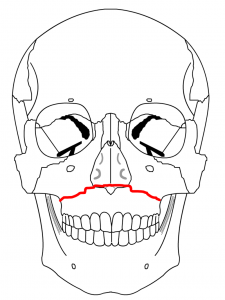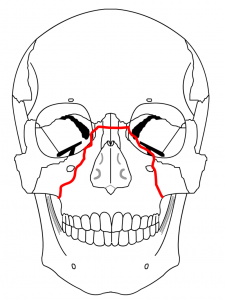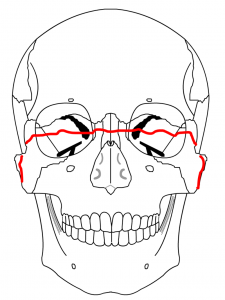
Maxillofacial & Dental
A 54 year old man is brought to the Emergency Department after getting hit in the face by the wing mirror of a passing lorry. On examination he is maintaining his own airway and you note bilateral periorbital ecchymosis (raccoon eyes) and clear deformity of the midface. Facial CT shows a Le Fort type II fracture. Which of the following structures MUST be fractured in a Le Fort type II injury?
Answer:
Le Fort fractures:- Anterolateral margin of the nasal fossa involvement:
- If fractured, it is a type I fracture
- If intact, it excludes a type I fracture
- Inferior orbital rim involvement:
- If fractured, it is a type II fracture
- If intact, it excludes a type II fracture
- Zygomatic arch involvement:
- If fractured, it is a type III fracture
- If intact, it excludes a type III fracture
- If the nasofrontal suture is involved, then it is either a type II or III fracture
Le Fort Fracture
Maxillofacial & Dental
Last Updated: 14th December 2023
Le Fort fractures are fractures of the midface, which collectively involve separation of all or a portion of the midface from the skull base. Fracture of the pterygoid plates is mandatory to diagnose Le Fort fractures, as these connect the midface to the sphenoid bone dorsally.
Low-velocity mechanism (fall from standing, blunt trauma) results in the majority of Le Fort I fractures. High-velocity mechanism (fall > 1 story, high-speed MVC) is associated with higher grade Le Fort fractures (e.g. II, III).
Classification
- Le Fort type I (Floating Palate)
- Horizontal fracture through maxilla above the roots of the teeth
- May result from a force of injury directed low on the maxillary alveolar rim in a downward direction
- Fracture extends through the alveolar ridge, lateral nose and inferior wall of the maxillary sinus; there is separation of the body of the maxilla from the pterygoid plate and nasal septum
- Le Fort type II (Floating Maxilla)
- Pyramidal fracture (teeth at the pyramid base and nasofrontal suture at its apex)
- May result from a blow to the lower or mid maxilla
- Fracture extends from the nasal bridge, at or below the nasofrontal suture, through the superior medial wall of the maxilla, inferolaterally through the lacrimal bones, through the orbital floor and inferior orbital rim, through the lateral wall of the maxillary sinus and the posterior alveolar ridge
- Le Fort type III (Floating Face)
- Transverse fracture causing craniofacial disjunction; the entire face is separated from the skull
- May follow impact to the nasal bridge or upper maxilla
- Fractures begin at the bridge of the nose and extend posteriorly along the medial wall of the orbit and the floor of the orbit, and then through the lateral orbital wall and the zygomatic arch; intranasally, they extend through all the lesser bones to the base of the sphenoid
Any combination is possible. For example, there may be type II on one side and contralateral type III, or there may be unilateral type I and II fractures. It should be noted that Le Fort fractures are often associated with other head and neck injuries e.g. skull or facial fracture, closed head injury, cervical spine injury, neuromuscular injury and dental avulsions/fractures.
KEY COMPONENTS:
- Anterolateral margin of the nasal fossa involvement:
- If fractured, it is a type I fracture
- If intact, it excludes a type I fracture
- Inferior orbital rim involvement:
- If fractured, it is a type II fracture
- If intact, it excludes a type II fracture
- Zygomatic arch involvement:
- If fractured, it is a type III fracture
- If intact, it excludes a type III fracture
- If the nasofrontal suture is involved, then it is either a type II or III fracture

Le Fort Type I Fracture. (Image by RosarioVanTulpe [CC BY-SA 2.5 , from Wikimedia Commons)

Le Fort Type II Fracture. (Image by RosarioVanTulpe [CC BY-SA 2.5 , from Wikimedia Commons)

Le Fort Type III Fracture. (Image by RosarioVanTulpe [CC BY-SA 2.5 , from Wikimedia Commons)
Clinical findings
- Severe facial ecchymosis (balloon face)
- Severe nasal or oral haemorrhaging
- Conjunctival hemorrhage
- CSF rhinorrhea
- Haemotympanum
- Anosmia
- Paraesthesias of the face
- Elongation of the face
- Nasal disfiguration
- Emphysema of the face
- Exophthalmos
- Raccoon eyes
- Auricular haematoma
- Pupil asymmetry
- Dental injuries
- Sinking over the anterior face (dish face)
Imaging
- Dedicated facial CT allows for imaging of orbits and fine fracture lines as well
- Consider CT C-spine given high incidence of concomitant cervical spine injury
- No role in plain films due to the complexity of the facial bones
Management
- Airway should always be managed first, protection from bleeding or mechanical disruption is key
- Severe bleeding may occur from the nose or oropharynx and these can be managed with anterior packing
- Posterior packing should be avoided if possible unless the skull base is known to be intact
- Tracheostomy may be required
- It is important to stabilise any serious injuries to airway, spine, chest, abdomen and skull prior to definitive treatment of facial bones
- After the primary stabilisation is achieved, other management can occur
- Elevate the head of the bed to 40-60 degrees for anyone with a possible CSF leak (if not in spinal precautions)
- Administer IV antibiotics, especially if CSF leak known or suspected
- Perform secondary exam
- Disposition
- Majority of patients require admission; the goal is to restore the facial skeleton and proper masticatory function
- Consult oral maxillofacial surgery (or whoever may be on call for facial trauma at your institution)
- Consider neurosurgery consult if CSF leak noted
- Consider ophthalmology consult within 24 hours depending on any ocular damage or involvement
Report A Problem
Is there something wrong with this question? Let us know and we’ll fix it as soon as possible.
Loading Form...
- Biochemistry
- Blood Gases
- Haematology
| Biochemistry | Normal Value |
|---|---|
| Sodium | 135 – 145 mmol/l |
| Potassium | 3.0 – 4.5 mmol/l |
| Urea | 2.5 – 7.5 mmol/l |
| Glucose | 3.5 – 5.0 mmol/l |
| Creatinine | 35 – 135 μmol/l |
| Alanine Aminotransferase (ALT) | 5 – 35 U/l |
| Gamma-glutamyl Transferase (GGT) | < 65 U/l |
| Alkaline Phosphatase (ALP) | 30 – 135 U/l |
| Aspartate Aminotransferase (AST) | < 40 U/l |
| Total Protein | 60 – 80 g/l |
| Albumin | 35 – 50 g/l |
| Globulin | 2.4 – 3.5 g/dl |
| Amylase | < 70 U/l |
| Total Bilirubin | 3 – 17 μmol/l |
| Calcium | 2.1 – 2.5 mmol/l |
| Chloride | 95 – 105 mmol/l |
| Phosphate | 0.8 – 1.4 mmol/l |
| Haematology | Normal Value |
|---|---|
| Haemoglobin | 11.5 – 16.6 g/dl |
| White Blood Cells | 4.0 – 11.0 x 109/l |
| Platelets | 150 – 450 x 109/l |
| MCV | 80 – 96 fl |
| MCHC | 32 – 36 g/dl |
| Neutrophils | 2.0 – 7.5 x 109/l |
| Lymphocytes | 1.5 – 4.0 x 109/l |
| Monocytes | 0.3 – 1.0 x 109/l |
| Eosinophils | 0.1 – 0.5 x 109/l |
| Basophils | < 0.2 x 109/l |
| Reticulocytes | < 2% |
| Haematocrit | 0.35 – 0.49 |
| Red Cell Distribution Width | 11 – 15% |
| Blood Gases | Normal Value |
|---|---|
| pH | 7.35 – 7.45 |
| pO2 | 11 – 14 kPa |
| pCO2 | 4.5 – 6.0 kPa |
| Base Excess | -2 – +2 mmol/l |
| Bicarbonate | 24 – 30 mmol/l |
| Lactate | < 2 mmol/l |

